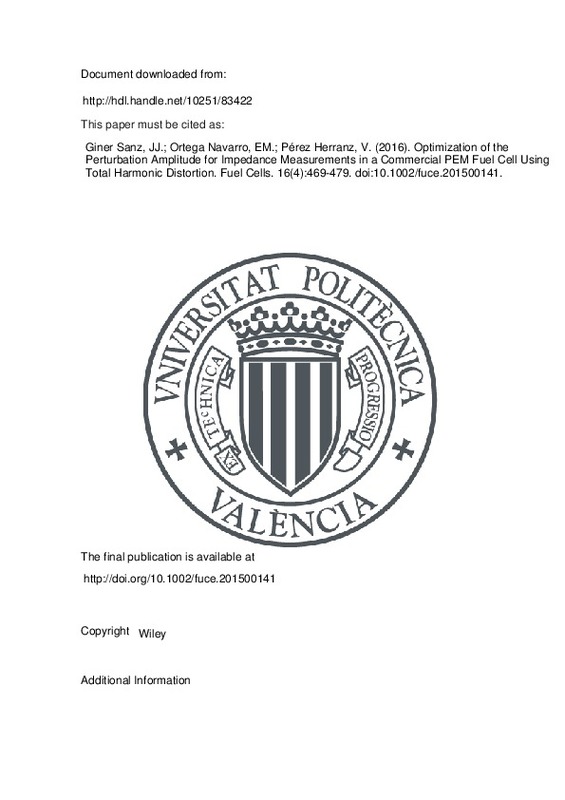JavaScript is disabled for your browser. Some features of this site may not work without it.
Buscar en RiuNet
Listar
Mi cuenta
Estadísticas
Ayuda RiuNet
Admin. UPV
Optimization of the Perturbation Amplitude for Impedance Measurements in a Commercial PEM Fuel Cell Using Total Harmonic Distortion
Mostrar el registro sencillo del ítem
Ficheros en el ítem
| dc.contributor.author | Giner Sanz, Juan José
|
es_ES |
| dc.contributor.author | Ortega Navarro, Emma María
|
es_ES |
| dc.contributor.author | Pérez Herranz, Valentín
|
es_ES |
| dc.date.accessioned | 2017-06-22T08:59:50Z | |
| dc.date.available | 2017-06-22T08:59:50Z | |
| dc.date.issued | 2016-08 | |
| dc.identifier.issn | 1615-6846 | |
| dc.identifier.uri | http://hdl.handle.net/10251/83422 | |
| dc.description.abstract | One of the most important measurement parameters in electrochemical impedance spectroscopy (EIS) is the perturbation amplitude. The optimum perturbation amplitude value corresponds with a balance between the signal-to-noise ratio improvement and the reduction of the harmonic generation due to nonlinear effects. Therefore, the optimum perturbation amplitude is the maximum amplitude that ensures a linear response of the system. Two strategies were considered in this work, i.e., a constant amplitude strategy and a frequency dependent amplitude strategy. On the one hand, for the constant amplitude strategy, the optimum perturbation amplitude for EIS measurements of an individual cell of a commercial PEM fuel cell stack was determined. In order to fulfill this aim, the impedance spectra (at different DC currents) of the individual cell of the commercial PEM fuel cell stack were measured using different perturbation amplitudes. The total harmonic distortion of the recorded voltage signal was determined in each case, applying a FFT based method. The optimum amplitude for each DC current corresponds to the amplitude that minimizes the critical total harmonic distortion value. On the other hand, for the frequency dependent amplitude strategy, the optimum amplitude at each frequency for EIS measurements of an individual cell of a commercial PEM fuel cell stack was determined. | es_ES |
| dc.language | Inglés | es_ES |
| dc.publisher | Wiley | es_ES |
| dc.relation.ispartof | Fuel Cells | es_ES |
| dc.rights | Reserva de todos los derechos | es_ES |
| dc.subject | Electrochemical Impedance Spectroscopy | es_ES |
| dc.subject | PEM Fuel Cells | es_ES |
| dc.subject | Perturbation Amplitude | es_ES |
| dc.subject | Total Harmonic Distortion | es_ES |
| dc.subject.classification | INGENIERIA QUIMICA | es_ES |
| dc.title | Optimization of the Perturbation Amplitude for Impedance Measurements in a Commercial PEM Fuel Cell Using Total Harmonic Distortion | es_ES |
| dc.type | Artículo | es_ES |
| dc.identifier.doi | 10.1002/fuce.201500141 | |
| dc.rights.accessRights | Abierto | es_ES |
| dc.contributor.affiliation | Universitat Politècnica de València. Departamento de Ingeniería Química y Nuclear - Departament d'Enginyeria Química i Nuclear | es_ES |
| dc.description.bibliographicCitation | Giner Sanz, JJ.; Ortega Navarro, EM.; Pérez Herranz, V. (2016). Optimization of the Perturbation Amplitude for Impedance Measurements in a Commercial PEM Fuel Cell Using Total Harmonic Distortion. Fuel Cells. 16(4):469-479. doi:10.1002/fuce.201500141 | es_ES |
| dc.description.accrualMethod | S | es_ES |
| dc.relation.publisherversion | http://doi.org/10.1002/fuce.201500141 | es_ES |
| dc.description.upvformatpinicio | 469 | es_ES |
| dc.description.upvformatpfin | 479 | es_ES |
| dc.type.version | info:eu-repo/semantics/publishedVersion | es_ES |
| dc.description.volume | 16 | es_ES |
| dc.description.issue | 4 | es_ES |
| dc.relation.senia | 312261 | es_ES |
| dc.identifier.eissn | 1615-6854 |







![[Cerrado]](/themes/UPV/images/candado.png)

